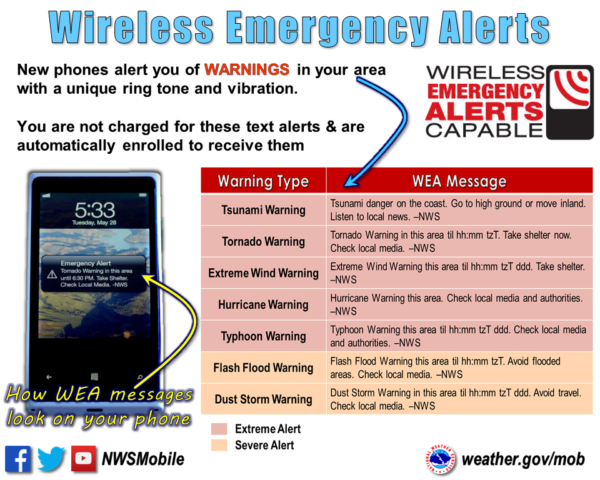2023 Severe Weather Awareness Week — Weather Alerts
When disaster strikes, you may have only a short time to make what might be a life or death decision. One of the most important things you can do is to be aware that a danger is present. Most of the injuries and deaths happen to people who are unaware or uninformed. For this reason, it is crucial that you have multiple ways to receive warning information.
NOAA Weather Radio
NOAA Weather Radio is also known as the voice of the National Weather Service. NOAA Weather Radio provides continuously updated weather information, 24 hours a day, every day of the year. National Weather Service personnel prepare weather information that is normally broadcast in three to five-minute cycles. This information includes forecasts, warnings, current conditions, climate data and other significant information.
To receive broadcasts from the National Weather Service, a special radio capable of receiving signals in the very high frequency, also known as VHF, public service band is required. Nationally, frequencies from 162.400 to 162.550 megahertz are used for NOAA Weather Radio broadcasts.
NOAA Weather Radio is useful anytime, but is most essential during severe weather. When threatening weather develops, normal broadcasts are interrupted by critical severe weather information. Watches, warnings, and statements are given the highest priority and are updated frequently.
In an emergency, each NOAA Weather Radio All-Hazards station will transmit a warning alarm tone signal followed by information on the emergency situation. This signal is capable of activating specially designed receivers by increasing the volume or producing a visual or audible alarm. Not all weather band receivers have this capability, but all radios that receive NOAA weather radio all hazards can receive emergency broadcasts.
A feature available in newer Weather Radio All-Hazards receivers is called “SAME” which stands for specific area message encoding. “SAME” technology allows radios to be programmed for the reception of watch and warning messages for certain counties in your area, without disturbing users for warnings outside the programmed counties. Local media outlets are urged to use NOAA weather radio for up-to-date weather information and may freely rebroadcast the NOAA weather radio all hazards transmission.
Emergency Alert System
Another source of weather information is the Emergency Alert System, also known as EAS, which replaced the emergency broadcast system. The EAS is a system of communication links that utilize data in a digital form. It is a reliable means of linking the National Weather Service, emergency management agencies, and various broadcast media together. The EAS will help participating radio and television stations receive and relay weather warnings and other emergency information in a timely manner.
Tornado Sirens
Something to keep in mind – even though tornado sirens are activated during Tornado Warnings, the sirens are for OUTDOOR purposes and are not meant to be heard indoors. We would like to stress to everyone to consider getting a NOAA Weather Radio to stay informed of warnings!
Wireless Emergency Alerts “WEA”
The Wireless Emergency Alert (WEA) service is a free notification service. When the National Weather Service issues certain weather warnings, cell towers will broadcast the alert to cell users in the threat area. The service is not subscription based, and it does not track your location. Users will only receive the emergency alerts if they are in the threat area. If you travel into an alert area after the alert was originally sent, you should still receive it. WEA consist of 3 alert types: Presidential Alerts, Imminent Threat Alerts (includes severe man-made or natural disasters) and AMBER Alerts.
Be The Hero
Help us spread the word! We don’t want anyone to not know about severe weather threats. If you know someone who doesn’t keep up with the weather, please SHARE important updates (from reliable sources) with them. Be their HERO!
Information and graphics courtesy of the National Weather Service.
Category: Alabama's Weather, ALL POSTS, Severe Weather




















